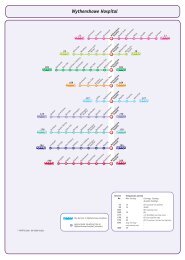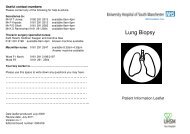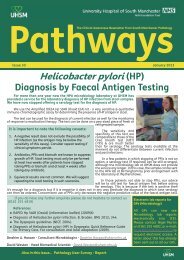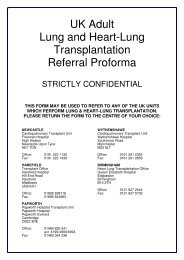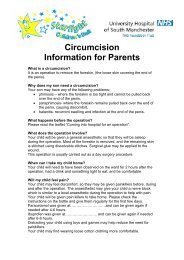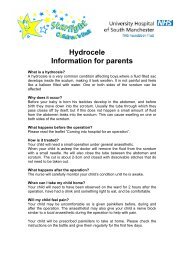Your Hospital - UHSM
Your Hospital - UHSM
Your Hospital - UHSM
Create successful ePaper yourself
Turn your PDF publications into a flip-book with our unique Google optimized e-Paper software.
RESEARCH & DEVELOPMENT<br />
Study offers alternative breast cancer therapy<br />
Prof Nigel Bundred<br />
Researchers believe a hormone<br />
therapy drug already used to treat<br />
breast cancer can significantly<br />
reduce its spread in women with a<br />
particular type of the disease.<br />
<strong>UHSM</strong>’s Professor Nigel Bundred,<br />
working with colleagues at the<br />
Christie and in Edinburgh and<br />
Nottingham studied whether the<br />
drug Exemestane (an aromatase<br />
inhibitor class drug) halted the<br />
growth of in-situ breast cancer and<br />
potentially prevented it progressing<br />
to invasive breast cancer by<br />
spreading outside of the ducts of<br />
the breast.<br />
Ductal cancer in-situ (DCIS)<br />
accounts for a quarter of all<br />
screen-detected breast cancer.<br />
Most patients with this type of<br />
disease are treated with breast<br />
conservation surgery followed<br />
often by radiotherapy and/or<br />
tamoxifen.<br />
However, cancer can return<br />
in as many as 30% of cases,<br />
and approximately half of<br />
all recurrences are invasive<br />
(potentially spreading cancer).<br />
Now, in a randomised trial<br />
involving 90 women who were all<br />
postmenopausal and diagnosed<br />
as having oestrogen receptor<br />
(ER) – positive DCIS, researchers<br />
have found that Exemestane<br />
was able to reduce DCIS growth<br />
regardless of tumour size. The<br />
results suggest that the drug is a<br />
potential alternative to tamoxifen<br />
in patients who have undergone<br />
breast conservation.<br />
Professor Nigel Bundred of the<br />
Department of Academic Surgery<br />
at <strong>UHSM</strong> says: “Breast cancer is<br />
the most common form of cancer<br />
in women, with around 40,000<br />
new cases diagnosed in the UK<br />
each year. About two-thirds of<br />
cases involve tumours that express<br />
oestrogen and/or progestogen,<br />
which makes them susceptible to<br />
hormonal therapy.<br />
“Currently, the first line hormonal<br />
therapy for women of all ages is<br />
tamoxifen. We have found that<br />
Exemestane has measured benefit<br />
for women with this particular type<br />
of cancer, while other studies show<br />
tamoxifen offers either limited or<br />
no benefit.”<br />
New asthma prevention study gets underway<br />
The largest ever study to<br />
investigate whether its possible<br />
to prevent children with hay fever<br />
going on to develop asthma is now<br />
underway at <strong>UHSM</strong>.<br />
Researchers from<br />
the North West<br />
Lung Centre,<br />
along with others<br />
from centres<br />
across the UK<br />
and Europe, are<br />
looking to recruit<br />
600 children<br />
between the<br />
ages of 4 and 11<br />
who have no asthma<br />
symptoms, but who have<br />
hay fever and need medication.<br />
• Anyone<br />
interested in taking<br />
part in the study<br />
should call 0800<br />
6556553 for more<br />
details.<br />
The idea is to study the youngsters<br />
to see if treatment with a<br />
prescribed and approved hay fever<br />
tablet, which contains natural grass<br />
pollen, can also reduce the risk of<br />
children with hay fever developing<br />
asthma. For the first three years,<br />
half the young recruits will be<br />
given the tablet every day and<br />
then followed for a further two<br />
years to determine if the<br />
treatment helps prevent<br />
them developing<br />
asthma. The other half<br />
will be given a placebo<br />
tablet.<br />
Research Manager,<br />
Gina Kerry, says:<br />
“We know that<br />
childhood allergic<br />
hay fever increases the<br />
risk of asthma development<br />
in later life by up to seven-fold.<br />
This trial will determine if this<br />
hay fever treatment can prevent<br />
development of asthma in children<br />
with grass pollen allergy.<br />
The North West Lung Centre where<br />
researchers are looking into<br />
asthma prevention<br />
“We really need people to come<br />
forward to take part in the trial as<br />
soon as possible.”<br />
• There will be a Health Matters<br />
talk on asthma by <strong>UHSM</strong>’s Dr Rob<br />
Niven on 16 June. See page 9 for<br />
more details.<br />
Medical Evaluation<br />
Unit success story<br />
The Medicines Evaluation Unit<br />
Ltd (MEU) is a modern purpose<br />
built respiratory clinical trial<br />
facility based at<br />
Wythenshawe <strong>Hospital</strong>.<br />
It was set up by the late Dr<br />
Steve Langley in 1994 and is<br />
managed by Dr Dave Singh<br />
(Medical Director), David<br />
Rogers (Director of<br />
Operations) and Liz Batty<br />
(Head of Nursing).<br />
Today the unit is viewed<br />
as a success due to the<br />
outstanding reputation for<br />
performing high quality<br />
clinical research. With over<br />
15 years experience in this<br />
field it is now a successful<br />
and thriving contract<br />
research organisation<br />
(CRO) with clients such as<br />
GlaksoSmithKline, Novartis,<br />
AstraZeneca and others<br />
extending around the globe.<br />
The MEU is a joint venture<br />
with <strong>UHSM</strong> and donates all<br />
profits through its charitable<br />
status to the North West<br />
Lung Centre charity.<br />
So far the unit has donated<br />
£1.3 million to the North West<br />
Lung Centre. This figure will<br />
continue to rise, supporting<br />
further respiratory academic<br />
studies. This in turn helps<br />
support respiratory research<br />
within the NHS, setting high<br />
standards and guaranteeing<br />
future clinical trials to be<br />
placed in this North West<br />
based unit.<br />
The MEU has extensive<br />
experience from working<br />
within the pharmaceutical<br />
industry and has developed<br />
many different compounds<br />
for asthma and chronic<br />
obstructive pulmonary<br />
disease (COPD)<br />
• Please see www.rewarding<br />
research.org.uk for further<br />
information.<br />
Colouring the way we feel . . .<br />
Prof Peter Whorwell<br />
People with anxiety<br />
and depression<br />
are more likely<br />
to use a shade of<br />
grey to represent<br />
their mental state<br />
than blue, according<br />
to <strong>UHSM</strong>’s Professor<br />
Peter Whorwell and his<br />
team of researchers from<br />
the University of Manchester.<br />
The researchers have created a wheel<br />
of colors of various intensities as an<br />
instrument to help diagnose depression<br />
and anxiety. “Colours are frequently<br />
used to describe emotions, such as<br />
being ‘green with envy or ‘in the blues,’”<br />
Prof Whorwell said.<br />
The study, published in February in BMC<br />
Medical Research Methodology, found<br />
people with depression or anxiety were<br />
more likely to associate their mood<br />
with the colour grey, while happier<br />
people preferred yellow. The results<br />
could help doctors gauge the moods of<br />
children and other patients who have<br />
trouble communicating verbally.<br />
“This is a way of measuring anxiety<br />
and depression which gets away<br />
from the use of language,” says<br />
gastroenterologist Peter Whorwell.<br />
“What is very interesting is that this<br />
might actually be a better way of<br />
capturing the patient’s mood.”<br />
Colors are often used as metaphors for<br />
moods, but no one had systematically<br />
researched colour associations, Prof<br />
Whorwell said. To investigate, he and<br />
his colleagues developed the colour<br />
wheel and then recruited 105 healthy<br />
Researchers’ wheel helps<br />
describe mood & depression<br />
adults, 110 anxious adults and 108<br />
depressed adults to the study. Each<br />
person was asked to pick their favourite<br />
colour, as well as the colour they were<br />
most “drawn to” and a colour that<br />
described their day-to-day<br />
mood over the last several<br />
months.<br />
Regardless of<br />
whether depressed,<br />
anxious or healthy,<br />
people liked blue<br />
and yellow. But<br />
when it came to<br />
mood, the groups<br />
diverged. Only 39<br />
percent of healthy<br />
people associated<br />
their mood with a<br />
colour at all. Of those<br />
who did, yellow was the<br />
most popular choice. Meanwhile,<br />
about 30% of people with anxiety<br />
picked a shade of grey, as did more<br />
than half of depressed volunteers.<br />
The researchers also found that when<br />
assigning a mood to colors, saturation<br />
matters. “A light blue is not associated<br />
with a poor mood, but a dark blue<br />
is,” Prof Whorwell said. “The shade<br />
of colour is more important than the<br />
colour itself.”<br />
Prof Whorwell is now testing the<br />
wheel on patients with irritable bowel<br />
syndrome. He’s hoping that colour<br />
choices can reveal patients’ attitudes<br />
and predict how well they will respond<br />
to treatments like hypnosis.<br />
Because people are embarrassed by<br />
gastroenterogical symptoms, Prof<br />
Whorwell said, non-verbal methods<br />
of getting information are sometimes<br />
preferable to conversation.<br />
And, he said, with additional research,<br />
the wheel could be used in medical<br />
fields from paediatrics to surgery.<br />
• Prof Whorwell will be giving a<br />
Health Matters talk on IBS on 21 April.<br />
See page 9 for more details.<br />
6 <strong>Your</strong> <strong>Hospital</strong> www.uhsm.nhs.uk<br />
7





